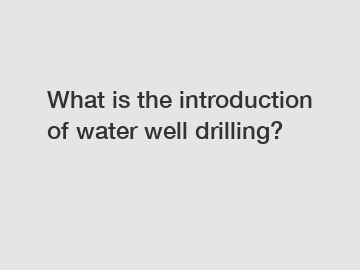Water well drilling is a process that involves drilling a hole into the ground to access groundwater for various purposes such as irrigation, drinking water supply, industrial use, and geothermal heating. It is a crucial undertaking that requires expert knowledge, specialized equipment, and careful planning to ensure the successful extraction of water from beneath the earth's surface.
Today, water well drilling is carried out by trained professionals who understand the geology of the area, the characteristics of the groundwater reservoir, and the necessary regulations and permits required for drilling. These experts use various types of drilling rigs and equipment to penetrate the earth's surface and reach the desired depth where water can be accessed.
The process of water well drilling begins with site evaluation and selection. Geologists and hydrologists survey the area to determine the best location for drilling based on factors such as groundwater availability, geology, and topography. Once a suitable site is identified, the drilling rig is brought in, and the drilling process begins.

There are several methods of drilling used in water well construction, including rotary drilling, cable tool drilling, and percussion drilling. Each method has its advantages and limitations, depending on the geology of the area and the depth of the well required. Rotary drilling, for example, is commonly used for drilling deep wells in hard rock formations, while cable tool drilling is preferred for shallow wells in softer sediments.
As the drilling progresses, the drill bit penetrates the earth's surface, creating a hole that is lined with casing to prevent collapse and contamination of the well. The casing also helps to stabilize the well and protect it from external elements that could compromise the quality of the water.
During the drilling process, samples of the drilled material are collected and analyzed to determine the geology of the area and the presence of any contaminants that could affect the water quality. This information is crucial for designing the well and selecting the appropriate pumping equipment to ensure a reliable and sustainable water supply.
Once the drilling is complete, the well is developed by removing the drilling mud and debris from the borehole to improve the flow of water into the well. Pump tests are conducted to determine the yield of the well and ensure that it meets the required standards for water quality and quantity.
Water well drilling is a complex and demanding process that requires expertise and precision to ensure the successful extraction of water from the ground. It is essential to work with experienced professionals who understand the geology of the area and have the necessary equipment and resources to complete the project safely and efficiently.
In conclusion, water well drilling is a vital activity that provides access to clean and safe drinking water for communities around the world. By understanding the principles and methods of water well construction, we can ensure the sustainable management of our precious water resources and secure a reliable water supply for future generations. So, when you need to drill a water well, make sure to hire a reputable and experienced drilling company to get the job done right.
Want more information on 3 1/2 Inch Drill Pipe, Reverse Circulation Drill Pipe, DTH Crawler-Mounted Water Well Drill Rig? Feel free to contact us.





Comments
All Comments ( 0 )